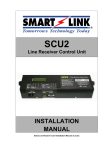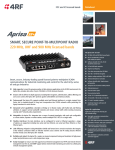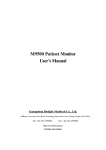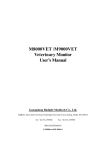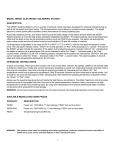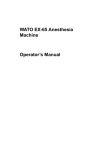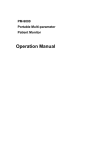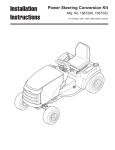Download Aprisa SR Product Description
Transcript
FICHA TECNICA DE: RADIO APRISA 4RF Product Description 2 | Compliance General The Aprisa SR digital radio predominantly operates within frequency bands that require a site license be issued by the radio regulatory authority with jurisdiction over the territory in which the equipment is being operated. It is the responsibility of the user, before operating the equipment, to ensure that where required the appropriate license has been granted and all conditions attendant to that license have been met. Changes or modifications not approved by the party responsible for compliance could void the user’s authority to operate the equipment. Equipment authorizations sought by 4RF Communications are based on the Aprisa SR radio equipment being installed at a fixed location and operated in point-to-multipoint mode within the environmental profile defined by EN 300 019, Class 3.4. Operation outside these criteria may invalidate the authorizations and / or license conditions. The term “Radio” with reference to the Aprisa SR User Manual, is a generic term for one end station of a point-to-multipoint Aprisa SR network and does not confer any rights to connect to any public network or to operate the equipment within any territory. Compliance ETSI The Aprisa SR radio is designed to comply with the European Telecommunications Standards Institute (ETSI) specifications as follows: Radio performance EN 300 113-2 EMC EN 301 489 Parts 1 & 5 Environmental EN 300 019, Class 3.4 Safety EN 60950-1:2006 Frequency band Channel size Power input 136-174 MHz 12.5 kHz 12 VDC 400-470 MHz 12.5 kHz 12 VDC Aprisa SR Product Description Notified body | 3 RF Exposure Warning WARNING: The installer and / or user of Aprisa SR radios shall ensure that a separation distance as given in the following table is maintained between the main axis of the terminal’s antenna and the body of the user or nearby persons. Minimum separation distances given are based on the maximum values of the following methodologies: 1. Maximum Permissible Exposure non-occupational limit (B or general public) of 47 CFR 1.1310 and the methodology of FCC’s OST/OET Bulletin number 65. 2. Reference levels as given in Annex III, European Directive on the limitation of exposure of the general public to electromagnetic fields (0 Hz to 300 GHz) (1999/519/EC). These distances will ensure indirect compliance with the requirements of EN 50385:2002. Frequency (MHz) Maximum Power (dBm) Maximum Antenna Gain (dBi) Minimum Separation Distance (m) 136 + 37 15 2.5 174 + 37 15 2.5 330 + 37 15 2.5 400 + 37 15 2.5 470 + 37 15 2.3 520 + 37 15 2.2 850 + 37 28 7.7 960 + 37 28 7.2 Aprisa SR Product Description Contents | 5 Contents 1. Introduction ................................................................................ 7 The 4RF Aprisa SR Radio......................................................................... 7 Product Overview ................................................................................ 8 Network Coverage and Capacity ........................................................ 8 Remote Messaging ......................................................................... 8 Repeater Messaging ....................................................................... 9 Product Features ................................................................................ 10 Functions .................................................................................. 10 Performance .............................................................................. 10 Usability ................................................................................... 10 Architecture...................................................................................... 11 Security ........................................................................................... 12 Interfaces......................................................................................... 13 Antenna Interface ........................................................................ 13 Ethernet Interface ....................................................................... 13 USB Interfaces ............................................................................ 13 RS-232 Interface .......................................................................... 13 Product Options ................................................................................. 14 Dual Antenna .............................................................................. 14 Mounting .......................................................................................... 15 DIN Rail Mounting ........................................................................ 15 Rack Shelf Mounting ..................................................................... 16 Wall Mounting ............................................................................. 17 2. Specifications ............................................................................ 18 RF Specifications ................................................................................ 18 ETSI Compliant............................................................................ 18 Frequency Bands .................................................................. 18 Channel Sizes ...................................................................... 18 Product Range ..................................................................... 18 Transmitter......................................................................... 19 Receiver ............................................................................ 19 Modem .............................................................................. 20 Data Payload Security ............................................................ 20 Interface Specifications ........................................................................ 21 Ethernet Interface ....................................................................... 21 RS-232 Asynchronous Interface ......................................................... 21 Power Specifications ............................................................................ 22 Power Supply.............................................................................. 22 Power Consumption ...................................................................... 22 Power Dissipation ........................................................................ 22 General Specifications .......................................................................... 23 Environmental ............................................................................ 23 Mechanical ................................................................................ 23 ETSI compliance .......................................................................... 23 Aprisa SR Product Description 6 | Contents 3. Management ............................................................................. 25 SuperVisor ........................................................................................ 25 Viewing the Aprisa SR Terminal Settings .............................................. 25 Configuring the Aprisa SR Terminal Details........................................... 26 Configuring the Aprisa SR RF Network Details ....................................... 26 Configuring the Aprisa SR Radio Settings ............................................. 27 Command Line Interface ....................................................................... 28 Management Display Panel..................................................................... 29 LED Display Panel ............................................................................... 30 Normal Operation ........................................................................ 30 Software Upgrade ........................................................................ 30 Test Mode ................................................................................. 31 4. Applications .............................................................................. 32 Basic point-to-multipoint application ........................................................ 32 Advanced point-to-multipoint application with repeater ................................. 33 Multi-interface point-to-multipoint application ............................................ 34 5. Architecture ............................................................................. 35 Product Description ............................................................................. 35 Frame ...................................................................................... 35 MAC Header ........................................................................ 35 Network Header ................................................................... 36 Payload .................................................................................... 36 Auxillary Frame ........................................................................... 36 Physical Layer............................................................................. 37 Data Link Layer / MAC layer ............................................................ 37 Channel Access .................................................................... 37 Hop by Hop Transmission......................................................... 37 Network Layer ............................................................................ 38 Packet Routing ..................................................................... 38 Product Operation............................................................................... 39 Carrier Sense Disabled ................................................................... 39 Carrier Sense Enabled ................................................................... 40 Product Architecture ........................................................................... 43 Radio Block Diagram ..................................................................... 44 Modem Block Diagram ................................................................... 44 6. Contact Us ................................................................................ 45 Aprisa SR Product Description Introduction | 7 1. Introduction The 4RF Aprisa SR Radio The 4RF Aprisa SR is a point-to-multipoint digital radio providing secure narrowband wireless data connectivity for SCADA, infrastructure and telemetry applications. The radios carry a combination of serial packet data and Ethernet data between the Base Station, Repeater Stations and Remote Stations. The Aprisa SR is configurable as a point-to-multipoint Base Station, a Remote Station or a Repeater Station. Aprisa SR Product Description 8 | Introduction Product Overview Network Coverage and Capacity In a simple point-to-multipoint network, an Aprisa SR, configured as a base station, will communicate with multiple remote units in a given coverage area. With a link range of up to 60 km a typical deployment will have 30 – 50 remote stations attached to the base station. However, geographic features, such as hills, mountains, trees and foliage, or other path obstructions, such as buildings, tend to limit radio coverage. Additionally, geography may reduce network capacity at the edge of the network where errors may occur and require retransmission. However, the Aprisa SR uses Forward Error Correction (FEC) which greatly improves the sensitivity performance of the radio resulting in less retries and minimal reduction in capacity. Ultimately, the overall performance of any specific network will be defined by a range of factors including the geographic location, the number of remote stations in the base station coverage area and the traffic profile across the network. ). Effective network design will distribute the total number of remote stations across the available base stations to ensure optimal geographic coverage and network capacity. Remote Messaging Base stations are fitted with omni-directional antennas and the remote stations use directional Yagi antennas for higher gain. On start-up the base station transmits a registration message which is recognised by the remote stations which respond with their own registration message. This allows the base station to record the details of all the remote stations active in the network. There are two message types in the Aprisa SR network, broadcast messages and unicast messages. Broadcast messages are transmitted by the base station to the remote stations and unicast messages are transmitted by the remote station to the base station. All the remote stations, within the coverage area, will receive the messages broadcast from the base station, but only the radio the message is intended for will action the message. Only the base station can receive the unicast messages transmitted from the remote station. Unicast messages are ignored by other remote stations which may be able to receive them. The Aprisa SR network is not designed for remote stations to communicate with other remote stations. Aprisa SR Product Description Introduction | 9 Repeater Messaging The Aprisa SR uses a routed protocol throughout the network whereby messages contain source and destination addresses. Upon registration, the radios populate an internal neighbor table to identify the radios in the network. The remote stations will register with a base station, or a repeater, and the repeater registers with a base station. In networks with a repeater, the repeater must register with the base station before the remotes can register with the repeater. Additionally, all messages contain a ‘message type’ field in the header and messages are designated as either a ‘broadcast’ message, originating from a base station, or a ‘unicast’ message, originating from a remote station. In a network with a repeater, or multiple repeaters, the base station broadcasts a message which contains a message type, a source address and a destination address. The repeater receives the message and recognizes it is a broadcast message, from the message type and source address and re-broadcasts the message across the network. All remote stations in the coverage area will receive the message but only the radio with the destination address will act upon the message. Similarly, the remote station will send a unicast message which contains a message type (unicast) a source address and a destination address (the base station). The repeater will receive this message; recognize the message type and source address and forward it to the destination address. It is this methodology which prevents repeater-repeater loops. If there is repeater (A) which, in some circumstances, is able to pick up the RF signal from another repeater (B), it will not forward the message as it will only forward broadcast messages from the base station (recognised by the source address). For unicast messages the repeater (A) will recognize that the message (from repeater (B)) is not from a remote with which it has an association and similarly ignore the message. Aprisa SR Product Description 10 | Introduction Product Features Functions • Point-to-Point (PTP) or Point-to-Multipoint (PMP) operation half duplex • Licensed frequency bands: VHF 136-174 MHz UHF 330-400 MHz † UHF 400-470 MHz UHF 450-520 MHz † UHF 850-960 MHz † • Channel sizes: 6.25 kHz † 12.5 kHz 25 kHz † † • Typical deployment of 30 Remote Stations from one Base Station with a practical limit of a few hundred Remote Stations. • Dual antenna option for external duplexers or filters (half duplex operation) • Ethernet data interface plus RS-232 asynchronous data interface. • Data encryption and authentication. • Complies with international standards, including ETSI RF, EMC, safety and environmental standards. Future Product Release Performance • Long distance operation (typically 30 km radius). • High transmit power. • Low noise receiver. • Forward Error Correction. • Electronic tuning over the frequency band. • Thermal management for high power over a wide temperature range. Usability • Configuration / diagnostics via front panel Management Port USB interface, Ethernet interface. • Remote station configuration / diagnostics over the radio link. • LED display for on-site diagnostics. • Optional management display for advanced on-site configuration. • Firmware upgrade and diagnostic reporting via the Host Port USB flash drive. • Simple installation with integrated mounting holes for wall, DIN rail and rack shelf mounting. Aprisa SR Product Description Introduction | 11 Architecture The Aprisa SR Architecture is based around a layered TCP/IP protocol stack: • Physical Proprietary wireless Standard RS-232 and Ethernet • Link Proprietary wireless (channel access, ARQ, segmentation) Standard Ethernet • Network Standard IP Proprietary automatic radio routing table population algorithm • Transport Standard TCP, UDP • Application Proprietary management application software Aprisa SR Product Description 12 | Introduction Security The Aprisa SR provides security features to implement the key recommendations for industrial control systems. The security provided builds upon the best in class from multiple standards bodies, including: • IEC/TR 62443 (TC65) “Industrial Communications Networks – Network and System Security”. • IEC/TS 62351 (TC57) “Power System Control and Associated Communications – Data and Communication Security”. It also adds additional security features through Layer 3 network integration. The security features implemented are: • Licensed radio spectrum protects against interference. • Proprietary physical layer protocol and modified MAC layer protocol based on standardized IEEE 802.15.4. • Data payload security: CCM • Counter with CBC-MAC integrity (NIST special publication 800-38C). Data encryption: Counter Mode Encryption (CTR) using Advanced Encryption Standard (AES). • Data authentication: Cipher Block Chaining Message Authentication Code (CBC-MAC) using Advanced Encryption Standard (AES). † • Secured management interface protects configuration. • Address filtering enables traffic source authorization • Distributed Layer 3 firewall protects remote nodes †. • Segregated traffic flow enables node isolation, with VLAN and Layer 3 subnets †. Future Product Release Aprisa SR Product Description †. Introduction | 13 Interfaces Antenna Interface Single Antenna Option • 1 x TNC, 50 ohm, female connector Dual Antenna Option • 2 x TNC, 50 ohm, female connectors Ethernet Interface • 2 x ports 10/100 base-T Ethernet layer 2 switch using RJ-45. Used for Ethernet user traffic and product management. USB Interfaces • 1 x Management Port using USB micro type B connector. Used for product configuration with the Command Line Interface (CLI). • 1 x Host Port using USB standard type A connector. Used for software upgrade and diagnostic reporting. RS-232 Interface • 1x RS-232 asynchronous port using RJ-45 connector. Used for RS-232 async user traffic only. Aprisa SR Product Description 14 | Introduction Product Options Dual Antenna The standard Aprisa SR uses a one or two frequency ½ duplex transmission mode which eliminates the need for a duplexer. However, a Dual Antenna option is available for separate transmit and receive antenna connection to support external duplexers or filters. The transmission remains half duplex. Antenna Option Part Number Single Antenna APSR-N400-012-SO-12-ETAA Dual Antenna APSR-N400-012-DO-12-ETAA Aprisa SR Product Description Introduction | 15 Mounting The Aprisa SR has four threaded holes (M4) in the enclosure base and two holes (5.2 mm) through the enclosure for mounting. Mounting options include: • DIN rail mounting with the Aprisa SR DIN Rail Mounting Bracket • Rack shelf mounting • Wall mounting • Outdoor enclosure mounting DIN Rail Mounting The Aprisa SR has an optional accessory part ‘4RF Aprisa SR Acc, Mounting, Bracket, DIN Rail’. Aprisa SR Product Description 16 | Introduction The Aprisa SR DIN rail mounting bracket can be mounted in four positions on a horizontal DIN rail: • Vertical Mount (vertical enclosure perpendicular to the mount) • Horizontal Mount (horizontal enclosure perpendicular to the mount). • Flat Vertical Mount (vertical enclosure parallel to the mount) • Flat Horizontal Mount (horizontal enclosure parallel to the mount) Rack Shelf Mounting The Aprisa SR can be mounted on a rack mount shelf using the four M4 threaded holes in the Aprisa SR enclosure base. The following picture shows Aprisa SR mounted on 1 RU rack mounted shelves. Aprisa SR Product Description Introduction | 17 Wall Mounting The Aprisa SR can be mounted on a wall using the two holes through the enclosure (5.2 mm diameter). Typically, M5 screws longer than 35 mm would be used. Aprisa SR Product Description 18 | Specifications 2. Specifications RF Specifications ETSI Compliant Frequency Bands Broadcast Band Frequency Band Frequency Tuning Range Synthesizer Step Size VHF 136 MHz 136-174 MHz 3.125 kHz 330-400 MHz 6.250 kHz UHF 330 MHz UHF † 400 MHz 400-470 MHz 6.250 kHz UHF 450 MHz † 450-520 MHz 6.250 kHz UHF 900 MHz † 850-960 MHz 6.250 kHz Channel Sizes Channel Size 6.25 kHz Gross Radio Capacity † 4.8 kbit/s 12.5 kHz 25 kHz † 9.6 kbit/s † 19.2 kbit/s Future Product Release Product Range Frequency Band (MHz) Channel Size (kHz) 6.25 12.5 25 4.8 9.6 19.2 136 330 400 450 900 Gross Radio capacity (kbit/s) Current Product Release Future Product Release Aprisa SR Product Description Specifications | 19 Transmitter Power output 0.1 to 5.0 W (+20 to +37 dBm, in 1 dB steps) Adjacent channel power < - 60 dBC Transient adjacent channel power < - 50 dBC Spurious emissions < - 37 dBm Attack time < 1.5 ms Release time < 1.5 ms Data turnaround time < 10 ms Frequency stability ± 1 ppm Frequency aging < 1 ppm / annum Synthesizer lock time < 1.5 ms (5 MHz step) Receiver † 12.5 kHz 25 kHz –119 dBm –117 dBm –114 dBm 6.25 kHz Receiver Sensitivity BER < 10-2 -3 –114 dBm BER < 10-6 –110 dBm BER < 10 Adjacent Selectivity > 60 dB Co-channel rejection > 60 dB > –12 dB Intermodulation response rejection > 70 dB Blocking or desensitization > 84 dB Spurious response rejection > 75 dB Aprisa SR Product Description † > 70 dB 20 | Specifications Modem Modulation 4-CPFSK Forward Error Correction ¾ Trellis code Data Payload Security † Data payload security CCM* Counter with CBC-MAC Data encryption Counter Mode Encryption (CTR) using Advanced Encryption Standard (AES) 128, 192 or 256 Data authentication Cipher Block Chaining Message Authentication Code (CBC-MAC) using Advanced Encryption Standard (AES) 128, 192 or 256 Future Product Release Aprisa SR Product Description Specifications | 21 Interface Specifications Ethernet Interface The Aprisa SR radio features an integrated 10Base-T/100Base-TX layer-2 Ethernet switch. To simplify network setup, each port supports auto-negotiation and auto-sensing MDI/MDIX. Operators can select from the following preset modes: • Auto negotiate • 10Base-T half or full duplex • 100Base-TX half or full duplex The switch is IEEE 802.3-compatible. It passes VLAN tagged traffic. General Diagnostics Interface RJ-45 x 2 (Integrated 2-port switch) Cabling CAT-5 UTP, supports auto MDIX (Standard Ethernet) Maximum line length 100 metres on cat-5 or better Bandwidth allocation The Ethernet capacity maximum is determined by the available radio link capacity. Maximum transmission unit Option setting of 1522 or 1536 octets Address table size 1024 MAC addresses Ethernet mode 10Base-T or 100Base-TX Full duplex or half duplex (Auto-negotiating and auto-sensing) Left Green LED Off: no Ethernet signal received On: Ethernet signal received Right Green LED Off: Indicates no data traffic present on the interface Flashing: Indicates data traffic present on the interface RS-232 Asynchronous Interface The Aprisa SR radio’s ITU-T V.24 compliant RS-232 interface is configured as a Cisco® pinout DCE. The interface terminates to a DTE using a straight-through cable or to a DCE with a crossover cable (null modem). The interface uses two handshaking control lines between the DTE and the DCE. General Async parameters Control signals Interface ITU-T V.24 / EIA/TIA RS-232E Interface direction DCE only Maximum line length 10 metres Standard mode data bits 7 or 8 bits Standard mode parity Configurable for None, Even or Odd Standard mode stop bits 1 or 2 bits Interface baud rates 300, 1200, 2400, 4800, 9600, 19200, 38400, 57600 and 115200 bit/s DCE to DTE CTS, RTS, DSR, DTR Aprisa SR Product Description 22 | Specifications Power Specifications Power Supply Nominal voltage +13.8 VDC (negative earth) Input voltage range +10 to +30 VDC Maximum power input 30 W Connector Phoenix Contact 4 pin male screw fitting MC 1.5/ 4-GF-3.5 Power Consumption Mode Transmit / Receive Power Consumption < 22.5 W for 5W transmit power < 15.0 W for 1W transmit power Receive only < 6 W full Ethernet traffic activity < 4.5 W no Ethernet traffic activity Power Dissipation Transmit Power Power Dissipation 1W transmit power < 14.0 W 5W transmit power < 17.5 W Aprisa SR Product Description Specifications | 23 General Specifications Environmental Operating temperature range -40 to +70˚ C Storage temperature range -40 to +80˚ C Operating humidity Maximum 95% non-condensing Acoustic noise emission No audible noise emission Dimensions Width 177 mm Depth 110 mm (126 mm with TNC connector) Height 41.5 mm Weight 720 g Colour Matt black Mounting Wall (2 x M5 screws) Rack shelf (2 x M4 screws) DIN rail bracket Mechanical ETSI compliance Radio EN 300 113 EMI / EMC EN 301 489 Parts 1 & 5 Safety EN 60950 Environmental ETS 300 019 Class 3.4 Aprisa SR Product Description Management | 25 3. Management SuperVisor The Aprisa SR contains an embedded web server application (SuperVisor) to enable element management with any major web browser (such as Mozilla Firefox, Microsoft® Internet Explorer). SuperVisor enables operators to configure and manage the Aprisa SR base station radio and repeater / remote station radios over the radio link. The key features of SuperVisor are: • View and set standard radio configuration parameters, including frequencies, transmit power, channel access, serial, Ethernet and USB port settings • Set terminal operating mode, whether base station, remote station or repeater station • Set and view security parameters, including keys • Display performance and alarm information, including RSSI, alarm status, time-stamped events, alarm parameters The following are four examples of SuperVisor screens: Viewing the Aprisa SR Terminal Settings The SuperVisor software enables operators to view the terminal settings: Aprisa SR Product Description 26 | Management Configuring the Aprisa SR Terminal Details The SuperVisor software enables operators to set the terminal details including: • Terminal Name • Location • Contact Name • Contact Details • Current Date • Ethernet port IP Address / Subnet Mask / Gateway Address Configuring the Aprisa SR RF Network Details The SuperVisor software enables operators to set the RF Network Details including: • Network ID (FAN) (Field Area Network) – four hex chars – network ID of this base station node and its remote nodes • Node Address – four hex chars – base station = 0000 – remote stations = 0001 to FFFD • Network Radius – sets the maximum number of hops in this network • Inband Management - enables Inband Management of Remotes / Repeaters • Inband Management Timeout (sec) - sets the Inband Management timeout period Aprisa SR Product Description Management | 27 Configuring the Aprisa SR Radio Settings The SuperVisor software enables operators to set the radio settings including: • Transmit frequency MHz • Transmit power dBm / watts • Receive frequency MHz • Channel type – link capacity vs channel size Aprisa SR Product Description 28 | Management Command Line Interface The Aprisa SR has a Command Line Interface (CLI) which provides basic product setup and configuration. This interface can be accessed via an Ethernet Port (RJ-45) or the Management Port (USB micro type B). The Terminal menu is shown in the following picture: Aprisa SR Product Description Management | 29 Management Display Panel The Aprisa SR has an optional Management Display Panel which provides on-site management and diagnostics without the need for PC. The features include: † • Displaying and changing frequencies • Enabling and disabling user interfaces • Displaying alarms • Displaying performance data • Performing upgrades • Performing onsite tests Future Product Release Aprisa SR Product Description 30 | Management LED Display Panel The Aprisa SR has an LED Display panel which provides on-site alarms / diagnostics without the need for PC. Normal Operation In normal radio operation, the LEDs indicate the following conditions: OK DATA CPU RF AUX Solid Red RF path transmit fail alarm Flashing Red Radio not connected to a Base Station Radio uncalibrated alarm Solid Orange RF path minor alarm Duplicate IP address condition detected in network RF path TX is active Copy of Alarm History file to the USB drive is in progress Flashing Orange Tx Data or Rx Data on the USB management port Flashing Green Tx Data or Rx Data on the serial port Solid Green Power on and functions OK All interface ports are OK Device detect on the USB host port RF path RX is active Processor Block is OK RF Path is OK Software Upgrade During a software upgrade, the LEDs indicate the following conditions: • Software upgrade started - the OK LED flashes orange • Software upgrade progress indicated by running AUX to DATA LEDs • Software upgrade completed successfully - the OK LED solid orange • Software upgrade failed - any LED flashing red during the upgrade Aprisa SR Product Description Management | 31 Test Mode In Test Mode, the LED Display panel presents a real time visual display of the RSSI. This can be used to adjust the antenna for optimum signal strength. Aprisa SR Product Description 32 | Applications 4. Applications This section describes sample Aprisa SR radio applications. The following applications are described: • Basic point-to-multipoint application • Advanced point-to-multipoint application with repeaters • Multi-interface point-to-multipoint application Basic point-to-multipoint application Single base station with Ethernet SCADA data inputs to multiple geographically remote sites with Ethernet RTUs requiring control and data acquisition. The base station receives Ethernet frames from the SCADA server LAN and broadcasts all Ethernet frames to all remote stations Each remote site receives Ethernet frames from the RTU and unicasts over the air to the base station. The base station uses an omni directional antenna to provide wide coverage and the remote stations are fitted with directional Yagi antennas to provide higher gain. Aprisa SR Product Description Applications | 33 Advanced point-to-multipoint application with repeater Single base station with Ethernet SCADA data inputs to multiple geographically remote sites with Ethernet RTUs requiring control and data acquisition. A repeater is deployed to service remote sites beyond the reach of the base station. The base station receives Ethernet frames from the SCADA server LAN and broadcasts all Ethernet frames to the repeater and its remote stations. Three remote sites have direct radio communication with the base station but the other two remote sites operate via the repeater site. Each remote site receives Ethernet frames from the RTU and unicasts over the air to the repeater / base station. The base station and the repeater station use an omni directional antenna to provide wide coverage and the remote stations are fitted with directional Yagi antennas to provide higher gain. Aprisa SR Product Description 34 | Applications Multi-interface point-to-multipoint application Single base station with Ethernet and RS-232 SCADA data inputs to multiple geographically remote sites with Ethernet and RS-232 RTUs requiring control and data acquisition. The base station receives Ethernet / RS-232 frames from the SCADA servers and broadcasts all frames to all remote stations Each remote site receives Ethernet / RS-232 frames from the RTU and unicasts over the air to the base station. The base station uses an omni directional antenna to provide wide coverage and the remote stations are fitted with directional Yagi antennas to provide higher gain. Aprisa SR Product Description Architecture | 35 5. Architecture Product Description There are three components to the wireless interface: the Physical Layer (PHY), the Data Link Layer (DLL) and the Network Layer. These three layers are required to transport data across the wireless channel in the Point-to-Multipoint (PMP) configuration. The Aprisa SR DLL is largely based on the 802.15.4 MAC layer using a proprietary implementation. An example wireless protocol frame structure is illustrated below. This uses maximum security of 16 Bytes. The length of the header varies depending on whether the user data must be segmented. User data will be segmented if it is larger than the wireless packet payload length. In this case, this limit is 213 Bytes. If the user data packet is larger than this, then the header increases to 20 Bytes to account for the transport of the required segmentation and reassembly data. This frame structure consists of: Frame MAC Header Frame Control The frame control field is used to maintain coexistence with IEEE 802.15.4 and ZigBee standards. Path Cost This field is used only during route discovery, but is present in all data frames. FAN ID The FAN ID may be any value between 0x0001 and 0x7fff, and represents the FAN. DA The Destination Address field defines the destination of the next hop, or 0xffff for broadcasts. SA The Source Address field defines the source of this hop. Aprisa SR Product Description 36 | Architecture Network Header Frame Control The frame control field at the Network Header allows the Daintree SNA to interpret the fields correctly. In addition, the ‘discover route’ field, in bits 6-7 determines if a unibroadcast should discover a route. Bit 15 is used to indicate an ACK is requested. DA The Destination Address field in the Network Header defines the ultimate destination (not current hop). SA The Source Address field in the Network Header defines the original source (not current hop). Radius The Radius field is decremented each hop until it reaches 0. Seq The sequence number uniquely identifies the packet. Payload Based on the security configuration, the payload could be either encrypted or un-encrypted. Auxillary Frame The Auxillary Frame fields are dependant on the security configuration chosen. MIC/MAC A 0-16 byte register for the Message Authentication Code. AES Counter A 4 byte counter reuired for encryption. IEEE Address An 8 byte IEEE MAC address. Aprisa SR Product Description Architecture | 37 Physical Layer The Aprisa SR PHY uses a one or two frequency ½ duplex transmission mode which eliminates the need for a duplexer. Remote nodes are predominantly in receive mode with only sporadic bursts of transmit data. This reduces power consumption. The Aprisa SR is a packet based radio. Data is sent over the wireless channel in discrete packets / frames, separated in time. The PHY demodulates data within these packets with coherent detection. The Aprisa SR PHY provides carrier, symbol and frame synchronisation predominantly through the use of preambles. This preamble prefixes all packets sent over the wireless channel which enables fast synchronisation. Data Link Layer / MAC layer The Aprisa SR PHY enables multiple users to be able to share a single wireless channel; however a DLL is required to manage data transport. The two key components to the DLL are channel access and hop by hop transmission. Channel Access Channel access is realized in the Aprisa SR using Carrier Sense Multiple Access (CSMA). In this mode, a pending transmission requires the channel to be clear. This is determined by monitoring the channel for other signals for a set time prior to transmission. This results in reduced collisions and improved channel capacity. There are still possibilities for collisions with this technique e.g. if two radios simultaneously determine the channel is clear and transmit at the same time. In this case an acknowledged transaction may be used. The transmitter requests an ACK to ensure that the transmission has been successful. If the transmitter does not receive an ACK, then random backoffs are used to reschedule the next transmission. There are a number of parameters that can be altered for the channel access such as back off times, number of retries etc. To enable the most efficient use of the channel these parameters will differ for each network (largely dependent on number of radios in the network). Hop by Hop Transmission Hop by Hop Transmission is realized in the Aprisa SR by adding a MAC address header to the packet. For 802.15.4, there are 2 addresses, the source and destination addresses. Aprisa SR Product Description 38 | Architecture Network Layer Packet Routing Packet routing is realized in the Aprisa SR by adding a network address header to the packet. This contains source and destination addresses. For the Network Layer, there are 2 addresses, the address of the originating radio and the address of the terminating radio (i.e. end to end network). This is required for routing packets across multiple hops e.g. PMP with repeaters. The Aprisa SR uses an automated method for performing address assignment and routing information. There are two types of packets: unicast and broadcast. Only the base station sends broadcasts which are received by all remote stations. User packets are not interpreted as the radio link is transparent. Traffic Data originating on the Base Station is broadcast to all Repeater Stations and Remote Stations. Data originating on a Remote Station is unicast to the Base Station only. This can be via multiple Repeater Stations. Data originating on a Repeater Station is unicast to the Base Station only. Data originating on a serial port is terminated on a serial port and data originating on an Ethernet port is terminated on an Ethernet port only. User Traffic User traffic is prioritized depending on the Serial and Ethernet Data Priority options. If the Serial and Ethernet Data Priority options are equal, then first come first served is invoked. Repeater stations repeat traffic also on a first come first served basis. Management Traffic Ethernet Management Traffic has the same priority as Ethernet User Traffic but if the radio is not licensed for Ethernet, the Ethernet Data Priority is set to Low. Aprisa SR Product Description Architecture | 39 Product Operation Carrier Sense Disabled The following timing diagram illustrates two transactions with Carrier Sense disabled on the Remote Stations. 1. The Base Station broadcasts 2 packets to all Remote Stations. The Base Station uses default settings e.g. 1 attempt. In this example, the 2nd packet (packet B) arrives over the wired interface at the Base Station for transmission over the air before the 1st packet (packet A) has left. The 2nd packet is queued. The timing diagram illustrates that the retry timer is used to schedule the 2nd packet in the same way as a 2nd attempt would be queued. 2. Remote Station 1 attempts to send a packet (packet C) to the Base Station without the use of carrier sense. In this case, a second Remote Station (Remote Station 2) also attempts to send a packet (packet D) to the Base Station at approximately the same time. In this case the 2 packets collide and the Base Station does not reply with an ACK. The Remote Station unicast retry timer times out and the 2nd attempt is sent. This attempt is successful and an ACK is received. In this case, channel access is ALOHA. Aprisa SR Product Description 40 | Architecture Carrier Sense Enabled The following timing diagram illustrates the same transactions with Carrier Sense enabled on the Remote Stations. Transmit packets are depicted as orange blocks and received packets are depicted as green blocks. 1. The Base Station broadcasts 2 packets to all Remote Stations. In this case, the transactions are identical to the previous example. 2. Remote Station 1 attempts to send a packet (packet C) to the Base Station with the use of carrier sense. Here the Remote Station detects that the channel is being used by Remote Station 2. The carrier sense polls the channel and requires 2 consecutive channel clear assessments before the channel is accessed. This enables the carrier sense system to detect a possible ACK. This is illustrated above with one of the carrier sense polls (poll 4) passing as it detects the gap between packet D and its associated ACK. Aprisa SR Product Description Architecture | 41 Repeater Timing for Base Station to Remote Station Transactions The following timing diagram illustrates repeater timing for Base Station to Remote Station transactions. Packets are scheduled by the Broadcast Retry Timeout and Broadcast Jitter parameters. Repeater Timing for Remote Station to Base Station Transactions The following timing diagram illustrates repeater timing for Remote Station to Base Station transactions. Packets are scheduled by the Unicast Retry Timeout and Unicast Retry Jitter parameters. Aprisa SR Product Description 42 | Architecture Repeater Timing for Queued Packets at the Repeater Station The following timing diagram illustrates repeater timing for queued packets at the Repeater Station. Packets are scheduled by the Unicast Leading Timeout and Unicast Leading Jitter parameters. Aprisa SR Product Description Architecture | 43 Product Architecture The following are the key components of the Aprisa SR design: High performance ΣΔ fractional-N synthesizer • 2x output frequency VCO for minimal pulling during transmit • Wideband design electronically tunes over entire band • Tx and Rx LO operate on the same frequency, reducing the tuning range of the VCO and therefore better noise performance • Proven ultra low noise technology – 50dB SNR easily achieved Direct IQ modulation • Simple IQ modulation line up reduces part count and improves MTBF • No mixing stages so no spurious responses present at the transmitter output Tx turn-on time limited primarily by PA ramping • Robust, closed-loop power control – fast, accurate power ramp up and down MOSFET PA device • High efficiency (>60% PAE at 8W) • Very low thermal resistance (2.5°C/W) Direct IQ down-conversion • Excellent Intermodulation distortion characteristics as channel filter can be placed directly after the mixer without impacting noise figure • High Q active channel filtering helps achieve selectivity performance • Low parts count and no crystal filters help to keep receiver performance extremely stable over temperature Integrated heat sink • Limits number of mechanical interfaces • Fin design optimized for natural convection Monitoring and software control • Temperature control loop shuts down transmitter when the temperature exceeds continuous operation at 70°C • Monitoring of RSSI and PA current help to make sure the RF hardware is functioning to specification Aprisa SR Product Description 44 | Architecture Radio Block Diagram Modem Block Diagram Aprisa SR Product Description Contact Us | 45 6. Contact Us Aprisa SR Product Description












































